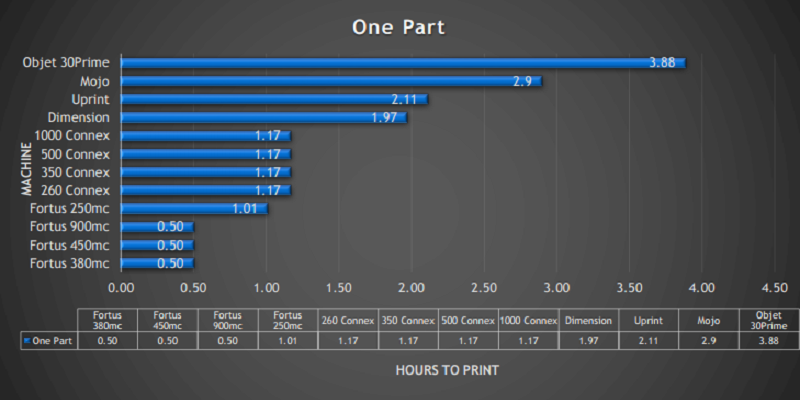“Our speed comparison methodology was designed to give a rough idea of printer speed comparisons—not a comprehensive study—and so we deliberately chose a single part that would be printed on all the Stratasys printers using a standard material for each technology (FDM and PolyJet),” says Juan Carlos Gandiaga, application engineer for CADD Edge. “We did test printing for a single part build and then printing 5, 10 and 20 parts at once…the span of speed varies greatly across the line of printers we sell, but there’s a lot more to this story than the ‘fastest’ printer.”
For example, Gandiaga continues, one of their top-performing printers blew all of the other printers out of the water with speeds five to twenty times the speeds of entry level printers; however, that same printer was exceptionally slow when printing a very small part. This may be frustrating to consumers who want their printers to be fast no matter what they’re printing, but that’s a great reason for publishing a paper of this sort. Buying a 3D printer is a huge investment, with a dizzying array of factors to consider before purchasing, and so it’s helpful to have a guide that breaks features down into the best performers for specific applications.
Stratasys printers tested in the study included:
FDM Printers:
- Mojo
- uPrint SE Plus
- Dimension
- Fortus 250mc
- Fortus 380/450/900mc (results for these three printers were identical)
PolyJet Printers:
- Objet30 Prime
- Objet Eden260VS
- Objet260 Connex3
- Objet350 Connex3
- Objet500 Connex3
- Objet1000 Plus
In general, FDM printers were twice as fast as PolyJet printers when printing a single part. PolyJets, however, became much faster when asked to print multiple parts at one time. No single printer stood out above all others as being the overall fastest or best. It’s an interesting study, and one that should be tremendously helpful for those considering purchasing a 3D printer. Usually, when buying a 3D printer, the customer has some general idea of what types of things they’ll be using it for, so a study like this one should help interested buyers to narrow their choices down to the printer that meets their specific needs. Even if you’re not in the market for a new printer right now, it’s still worth taking a look at; the download is free and contains a lot of information that’s very helpful in terms of better understanding printer speed and the many factors that go into it. Discuss in the 3D Printer Speeds forum over at 3DPB.com.
